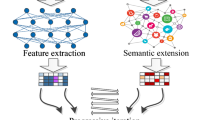Abstract
User-provided tags for social images have facilitated many fields, such as social image organization, summarization and retrieval. Since the users utilize their own knowledge and personalized language to describe the visual content of social images, these social tags are too imprecise and ambiguous to exploit the social image tagging. In this paper, we discover the content-similar images (peers) and leverage the relationships among these images (peer cooperation) to handle the problem of content-irrelevant tags. A bi-layer clustering framework for discovering content-similar images is proposed to divide image collection into different groups, and the tags of peers in these groups are cleaned jointly based on tag statistics and relevance. The relevance of tags measured by Google Distance is used to generate the first-layer clustering and then the bi-modality similarity of images is used to perform the second-layer clustering. Based on the bi-layer clustering, we utilize peers in a group to identify their content-irrelevant tags. Finally, an extended Fisher’s criterion is proposed to decide the proper number of content-irrelevant tags. To verify the effectiveness of our proposed technique, we conduct the experiments on the social images of Flickr and the standard benchmark. The comparison experiments show that our proposed algorithm achieves positive results for tag cleansing and image retrieval.













Similar content being viewed by others
Notes
In [11], authors use the Google search engine and name the approach with ‘Google distance’. We still use the same name even if we utilize the BING search engine and other database in this paper.
The NMF method constructs the estimated image-tag matrix V ′ using the matrix factorization V≈W H (V is the original image-tag matrix). Most zero entities in V would be updated to non-zero by updating W and H through minimizing the objective function F= ∑i=1n ∑j=1m[V i j l o g(W H) i j −(W H) i j ].
References
Bing. http://www.bing.com/images.
Flickr. http://www.flickr.com/.
Flickr blog. http://www.flickr.com/photos/franckmichel/6471458477/in/photostream.
Picasa web alums. https://picasaweb.google.com/home.
Wordnet. http://wordnet.princeton.edu/.
Ames, M., & Naaman, M. (2007). Why we tag: motivations for annotation in mobile and online media. In: Proceedings of the SIGCHI conference on Human factors in computing systems, (pp. 971–980). ACM.
Bird, S., Klein, E., Loper, E. (2009). Natural language processing with Python. O’Reilly Media, Incorporated.
Cattuto, C., Benz, D., Hotho, A., Stumme, G. (2008). Semantic analysis of tag similarity measures in collaborative tagging systems. arXiv preprint arXiv:0805.2045.
Chua, T.S., Tang, J., Hong, R., Li, H., Luo, Z., Zheng, Y. (2009). Nus-wide: a real-world web image database from national university of singapore. In: Proceedings of the ACM International Conference on Image and Video Retrieval, CIVR ’09, (pp. 48:1–48:9). ACM, New York.
Cilibrasi, R., & Vitányi, P.M. (2005). Clustering by compression. IEEE Transactions on Information Theory, 51(4), 1523–1545.
Cilibrasi, R.L., & Vitanyi, P.M.B. (2007). The google similarity distance. IEEE Transactions on Knowledge and Data Engineering, 19(3), 370–383.
Fan, J., Shen, Y., Zhou, N., Gao, Y. (2010). Harvesting large-scale weakly-tagged image databases from the web. In: CVPR’10, (pp. 802–809).
Frey, B., & Dueck, D. (2007). Clustering by passing messages between data points. Science, 315(5814), 972.
Garg, N., & Weber, I. (2008). Personalized, interactive tag recommendation for flickr. In: Proceedings of the 2008 ACM conference on Recommender systems, (pp. 67–74). ACM.
Jia, Y., Wang, J., Zhang, C., Hua, X.S. (2008). Finding image exemplars using fast sparse affinity propagation. In: Proceedings of the 16th ACM international conference on Multimedia, MM ’08, (pp. 639–642). ACM.
Kang, F.Automatic image annotation. Ph.D. thesis (2007). AAI3282132.
Kennedy, L., Naaman, M., Ahern, S., Nair, R., Rattenbury, T. (2007). How flickr helps us make sense of the world: context and content in community-contributed media collections. In: Proceedings of the 15th international conference on Multimedia, (pp. 631–640). ACM.
Lee, D.D., Seung, H., et al. (1999). Learning the parts of objects by non-negative matrix factorization. Nature, 401(6755), 788–791.
Lee, S., De Neve, W., Plataniotis, K., Ro, Y. (2010). Map-based image tag recommendation using a visual folksonomy. Pattern Recognition Letters, 31(9), 976–982.
Lee, S., De Neve, W., Ro, Y.M. (2010). Tag refinement in an image folksonomy using visual similarity and tag co-occurrence statistics. Image Commun, 25(10), 761–773.
Li, X., Snoek, C.G., Worring, M. (2008). Learning tag relevance by neighbor voting for social image retrieval. In: Proceedings of the 1st ACM international conference on Multimedia information retrieval, MIR ’08, (pp. 180–187). ACM.
Lin, C.J. (2007). Projected gradient methods for nonnegative matrix factorization. Neural computation, 19(10), 2756–2779.
Liu, D., Hua, X.S., Wang, M., Zhang, H.J. (2010). Image retagging. In: Proceedings of the international conference on Multimedia, MM ’10, (pp. 491–500). ACM.
Liu, J., Li, Z., Lu, H. (2013). Sparse semantic metric learning for image retrieval. Multimedia Systems, 1–9.
Olson, D.L., & Delen, D. (2008). Advanced data mining techniques. Springer.
Qiu, G. (2002). Indexing chromatic and achromatic patterns for content-based colour image retrieval. Pattern Recognition, 35(8), 1675–1686.
Sang, J., Xu, C., Liu, J. (2012). User-aware image tag refinement via ternary semantic analysis. IEEE Transactions on Multimedia, 14(3), 883–895.
Shen, Y., & Fan, J. (2010). Leveraging loosely-tagged images and inter-object correlations for tag recommendation. In: Proceedings of the international conference on Multimedia, (pp. 5–14). ACM.
Sigurbjörnsson, B., & Van Zwol, R. (2008). Flickr tag recommendation based on collective knowledge. In: Proceedings of the 17th international conference on World Wide Web, (pp. 327–336). ACM.
Solskinnsbakk, G., & Gulla, J.A. (2011). Mining tag similarity in folksonomies. In: Proceedings of the 3rd international workshop on Search and mining user-generated contents, (pp. 53–60). ACM.
Tang, J., Hong, R., Yan, S., Chua, T.S., Qi, G.J., Jain, R. (2011). Image annotation by k nn-sparse graph-based label propagation over noisily tagged web images. ACM Transactions on Intelligent Systems and Technology (TIST), 2(2), 14.
Tang, J., Yan, S., Hong, R., Qi, G.J., Chua, T.S. (2009). Inferring semantic concepts from community-contributed images and noisy tags. In: Proceedings of the 17th ACM international conference on Multimedia, MM ’09, (pp. 223–232). ACM.
Wang, M., Ni, B., Hua, X., Chua, T. (2012). Assistive tagging: A survey of multimedia tagging with human-computer joint exploration. ACM Computing Surveys (CSUR), 44(4), 25.
Wu, L., Jin, R., Jain, A.K. (2013). Tag completion for image retrieval. IEEE Transactions on Pattern Analysis and Machine Intelligence, 35(3), 716–727.
Wu, L., Yang, L., Yu, N., Hua, X.S. (2009). Learning to tag. In: Proceedings of the 18th international conference on World wide web, WWW ’09, (pp. 361–370). ACM.
Xia, Z., Peng, J., Feng, X., Fan, J. (2012). Social tag enrichment via automatic abstract tag refinement. In: Advances in Multimedia Information Processing PCM 2012, Lecture Notes in Computer Science, vol. 7674, (pp. 198–209). Springer, Berlin.
Zhu, G., Yan, S., Ma, Y. (2010). Image tag refinement towards low-rank, content-tag prior and error sparsity. In: Proceedings of the international conference on Multimedia, MM ’10, (pp. 461–470). ACM.
Acknowledgments
This work is partly supported by the doctorate foundation of Northwestern Polytechnical University (Grant No: CX201113), Doctoral Program of Higher Education of China (Grant No. 201161 02110027) and National Natural Science Foundation of China (under Grant No.61075014).
Author information
Authors and Affiliations
Corresponding author
Rights and permissions
About this article
Cite this article
Xia, Z., Feng, X., Peng, J. et al. Content-Irrelevant Tag Cleansing via Bi-Layer Clustering and Peer Cooperation. J Sign Process Syst 81, 29–44 (2015). https://doi.org/10.1007/s11265-014-0895-y
Received:
Revised:
Accepted:
Published:
Issue Date:
DOI: https://doi.org/10.1007/s11265-014-0895-y




